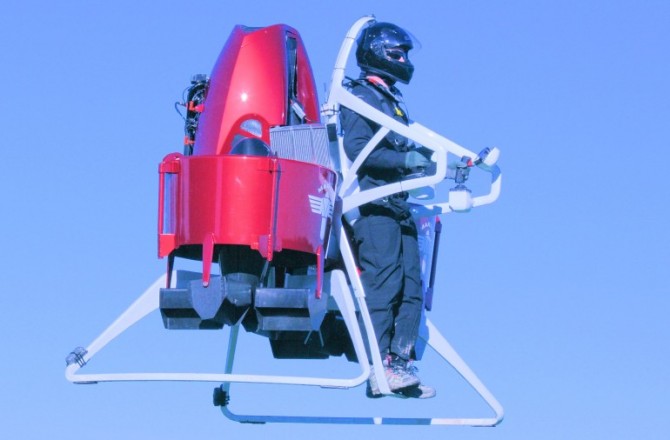The world’s first commercial jetpack… coming to a garage near you?
Ok, maybe not to your garage. But the first commercial jetpack is expected to be available later this year.
New Zealand-based Martin Aircraft has announced that it will begin selling its manned jetpack in the second half of 2016 for about $150,000. The AP reported that the jetpack is being designed for first responders such as firefighters. Martin Aircraft chief executive Peter Coker says the company will focus on jetpacks for first responders now, and later for other commercial operators.
The jetpack enables first responders to quickly get to hard to reach locations. It can easily carry a fireman to the top of a building. The jetpack can also take first responders to locations that are are “too constricted” for helicopters.
How does it work?
The Martin Jetpack isn’t actually a classic “jet” pack: It is not jet-powered. Instead, it runs on a V4 200 horsepower gasoline-powered engine that drives two ducted fans.
The jetpack’s impressive capabilities:
- Flight time: 30 minutes
- Speed: Up to 74 kilometers per hour (46 mph)
- Altitude: Up to 1000 meters (3280 feet)
- Max Payload: 120 kilograms. (265 pounds)
Video credit: New China TV
MATLAB, Simulink, and the Martin Jetpack
Martin Aircraft founder Glenn Martin started his research in 1981, three years before MathWorks was founded. He confirmed that the jetpack project started using MATLAB during the 1990s. In 2010, the team adopted Simulink as well. They developed a complete flight dynamics model of how the jetpack flies from experimental data put into Simulink.
“This was very useful to us and allowed many “what if’s” including better control algorithms,” says Glenn Martin, founder of Martin Aircraft and inventor of the Martin Jetpack.
The type of controls problems faced in such a project sounds like a “made for MATLAB” design endeavor. I also took a look at nearby Canterbury University’s recent research projects, and found that the continuing research on the Martin Jetpack does indeed utilize MATLAB and Simulink.
Martin Jetpack Research Papers: (Spelling is in keeping with the Queen’s English.)
A mathematical model of a twin ducted-fan vertical takeoff and landing jetpack (Michael Speck, Jörg Buchholz, and Mathieu Sellier)
“In order to improve the flight performance of the Martin Jetpack research was undertaken to investigate the aerodynamic issues that were limiting the P-11A Jetpack’s flight envelope. Through research of existing ducted-fan aircraft, a flight model describing the unique aerodynamics of the Martin Jetpack was developed using MATLAB/Simulink software. The dynamic flight model, which can be ran in real time, includes the reactions from: ducted-fans, aircraft body aerodynamics, control surfaces, gyration and landing gear interactions.”
Feasibility of an Electric Jetpack (Timothy Youard)
“The goal of this project was to determine the feasibility of an electrically powered version of the Martin Jetpack… A permanent magnet brushless DC (PMBLDC) motor simulation program was developed using MATLAB which could be used to optimise preliminary custom designs… Research into motor technologies showed that the PMBLDC motor was the most suited type for the Electric Jetpack.”
Jetpack + Oculus Rift VR Headset = Awesome Flight Simulator
So, you really want your own jetpack but just don’t have an extra $150,000 and you’re not a first responder. Here’s the next best thing: A jetpack flight simulator. The team at Martin Aircraft has created a truly 21st century flight simulator. The company showed off its prototype at an air show last year, using a simulator outfitted with an Oculus Rift VR headset to let visitors experience the product without lifting off the ground.
Image credit: AP Photo/Nick Perry
Jetpacks + VR. Brilliant!
If you are interested in VR, check out how Simulink blocks and MATLAB apps and functions are used to connect models to virtual reality worlds.










댓글
댓글을 남기려면 링크 를 클릭하여 MathWorks 계정에 로그인하거나 계정을 새로 만드십시오.